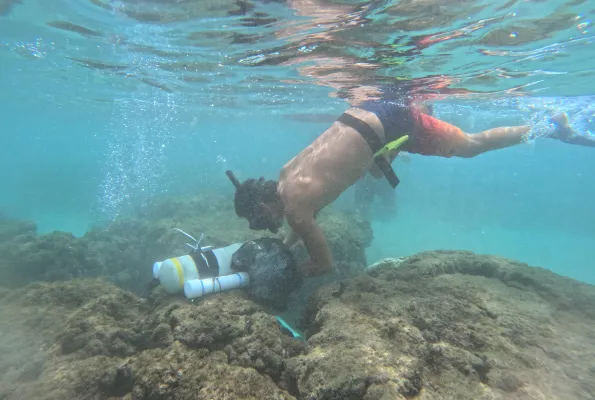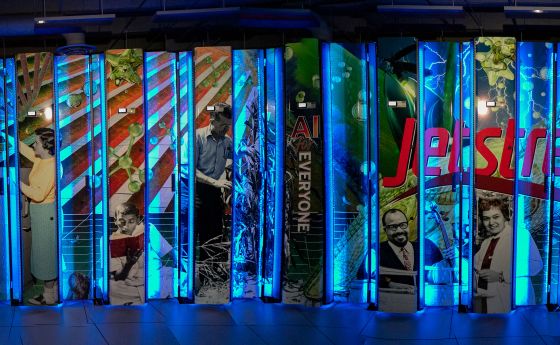
Researchers study Lahaina wildfires effects on coral reef health
A devastating fire burned through the city of Lahaina. With NSF support, researchers are working with the community to investigate if the local coral reef was impacted.
In August 2023, a combination of drought, hurricane winds and low humidity generated an unprecedented fire in Lahaina, a coastal city on the island of Maui, Hawaii.
The fire burned over 2,170 acres and 2,200 structures and released ash, particulate matter and potentially toxic materials into the coastal waters near Lahaina. Rarely has a coral reef been threatened by an urban fire. In the aftermath, community members had many questions, and one remained largely unanswered: Was the reef impacted?
Coral reefs are an essential part of not only tradition and tourism but also of food supplies in Hawaii. In a state in which over 85% of food is imported, a source of locally available, easily accessible nutrition is critical to food security. After the fire, the community asked: Was the water was safe? Could the fish still be eaten? Would this fire affect the future of the reef?
These questions united four researchers associated with the University of Hawaii at Mānoa (UH Mānoa). Andrea Kealoha, Craig Nelson, Eileen Nalley and Nicholas Hawco each saw ways to use their expertise to provide meaningful support for their community. Kealoha, who grew up on Maui, is an expert in coral reef health; Nelson's research focuses on the microbial ecology of coral reefs; Nalley studies the transfer of pollutants up the food chain; and Hawco has spent his career investigating the biogeochemical cycles of metals in the ocean.
The team's primary focus was on the impacted community. "It is important to understand the history and importance of the place you are working in, and how people connect to that place," Kealoha said. "We worked with the community to develop our research questions and will ensure that the data we collect is accessible to everyone."
Learn more about coral reefs:
Quick response plan
With support from a U.S. National Science Foundation Rapid Research Response (RAPID) grant, the team quickly started collecting water samples to gather information on what pollutants were found, where they were found and whether the concentrations of these pollutants were changing. This research could swiftly give the community answers.
The researchers were challenged to create an unprecedented sampling plan. To start, they pored over maps looking for potential contaminant hot spots while reaching back out to the community. Locals were able to quickly point out what areas were culturally important and/or of local concern, such as Baby Beach; a calm, shallow beach where families often take young children. Those who worked on the reef, such as the fishing community, gave insight on its structure and the currents that surrounded it. This collective knowledge was combined with the researchers' expertise to create a water quality site map across the island's coast.
The team used this map to plan out 11 water sample collection sites that it would visit on a set schedule and after major storm events. Using funds from the NSF RAPID grant, a sampling team of three undergraduate students and three graduate students stepped up to coordinate and carry out the plan. Responsible for both onshore and offshore sampling, they traveled between study sites by boat or car, often having to obtain special permission from safety officials to collect samples for laboratory processing. During these sampling trips the student team talked directly with the residents of Maui and saw firsthand the impact of their work.
The UH Mānoa team also used the site map to place water quality sensors. These sensors are costly, but they collect ongoing, updated measurements such as temperature, salinity and oxygen content to give live updates of reef health. Not only did researchers and community members work together to investigate reef health, but businesses also lent their support. Precision Measurement Engineering, Sea & Sun Technology and Sea-bird Scientific loaned or donated water quality sensors, giving the researchers a tangible, active track record of ongoing water quality in response to storm runoff events and potential stressors such as sedimentation and low oxygen.
Was the water safe?
The team's initial results from the water samples and instruments have painted a picture of the aftermath of the fire, fire-related stressors and the influx of pollutants resulting from storm runoff. The researchers observed that in areas where boats had burned during the fire, such as the harbor and the pier, copper concentrations were initially found at levels that were toxic to aquatic organisms, most likely due to copper being a common ingredient in the anti-fouling paint used to keep boats algae-free. However, the sampling team's ongoing work has shown that these concentrations have slowly decreased to safe levels over time.
Lead was never present at harmful levels, but like the copper concentrations, the low levels of lead that were present have decreased.
The research team discovered that some elements such as zinc showed the opposite trend. These elements were present at high concentrations in the burn zone after the fire but increased to even higher concentrations after the first large storm event when runoff flowed into the ocean. The team plans to keep a close eye on these concentrations, as their impact on the health of the reef remains unknown.
Copper and lead decreasing provide the team a positive picture of water safety. These concentrations have lowered to reef-safe levels. However, the research team will still carefully monitor the possibility of increasing element concentrations. Some of these elements, such as zinc, naturally occur in soils and ocean water, but high concentrations due to greater runoff and sedimentation along the reef following the fire can potentially impact things like coral fertilization, ultimately impacting reef health.
Could the fish still be eaten?
Given the presence of some concerning contaminants in the water, the team moved onto the next question: are the fish safe to eat? With the influx of pollutants from the fire, the team was concerned that the fish might be accumulating toxic metals and organic pollutants over time. In order to test the fish, they needed to collect the fish.
To get started, Nalley talked to local fishers, who know the reef well. Not only do fishers know where different species live, they know vital context about the broader reef ecosystem and the best way to catch fish. Nalley initiated a partnership, now an ongoing collaboration, between the research team and local fishers. Together they will target species and locations important to the community. Each fish sample collected by the fishers will be sent to a laboratory for contaminant testing.
Would this fire affect the future of the reef?
With water quality and fish contamination studies still ongoing, the community and researchers are carefully watching the long-term health of the reef. The student team is still collecting water samples, sensors are still measuring reef health and fish are still being caught and tested.
However, initial results show a positive future. Copper and lead concentrations in the water decreased as sampling went on and the water concentrations of one of the contaminants of largest concern, arsenic, was found to have been unaffected by the fire. The team was able to safely put major concerns about water safety to rest.
The research team will continue to carefully monitoring the suite of chemical levels, microbial communities, fish contaminants and reef health. With both the rate and size of fires increasing across the globe, they have provided a vital road map for future researchers looking to help provide answers for their urban communities near coral reefs.
"It's wonderful that this project can advance understanding of the effects of multiple environmental stressors on coral reef ecosystem function, while also having direct benefits for local community concerns," said NSF Division of Ocean Sciences Program Director Jayne Gardiner.
Learn more about this NSF-supported effort:



